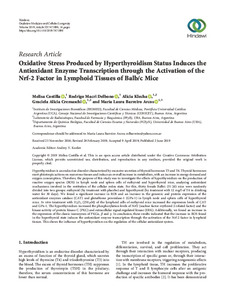Please use this identifier to cite or link to this item:
https://repositorio.uca.edu.ar/handle/123456789/8673| Título: | Oxidative stress produced by hyperthyroidism status induces the antioxidant enzyme transcription through the activation of the nrf-2 factor in lymphoid tissues of balb/c mice | Autor: | Costilla, Melisa Macri Delbono, Rodrigo Klecha, Alicia Juana Cremaschi, Graciela A. Barreiro Arcos, María Laura |
Palabras clave: | HIPERTIROIDISMO; GANGLIOS LINFATICOS; ESTRES OXIDATIVO | Fecha de publicación: | 2019 | Editorial: | Hindawi | Cita: | Costilla M, Macri Delbono R, Klecha A, Cremaschi GA, Barreiro Arcos ML. Oxidative Stress Produced by Hyperthyroidism Status Induces the Antioxidant Enzyme Transcription through the Activation of the Nrf-2 Factor in Lymphoid Tissues of Balb/c Mice [en línea]. Oxidative Medicine and Cellular Longevity 2019. doi:10.1155/2019/7471890 Disponible en: https://repositorio.uca.edu.ar/handle/123456789/8673 | Resumen: | Abstract: Hyperthyroidism is an endocrine disorder characterized by excessive secretion of thyroid hormones T3 and T4. Thyroid hormones exert pleiotropic actions on numerous tissues and induce an overall increase in metabolism, with an increase in energy demand and oxygen consumption. Therefore, the purpose of this study was to investigate the effects of hyperthyroidism on the production of reactive oxygen species (ROS) in lymph node and spleen cells of euthyroid and hyperthyroid mice, analyzing antioxidant mechanisms involved in the restitution of the cellular redox state. For this, thirty female Balb/c (H-2d) mice were randomly divided into two groups: euthyroid (by treatment with placebo) and hyperthyroid (by treatment with 12 mg/l of T4 in drinking water for 30 days). We found a significant increase in ROS and an increase in the genomic and protein expression of the antioxidant enzymes catalase (CAT) and glutathione peroxidase-1 (GPx-1) in lymph node and spleen cells of hyperthyroid mice. In vitro treatment with H2O2 (250 μM) of the lymphoid cells of euthyroid mice increased the expression levels of CAT and GPx-1. The hyperthyroidism increased the phosphorylation levels of Nrf2 (nuclear factor erythroid 2-related factor) and the kinase activity of protein kinase C (PKC) and extracellular signal-regulated kinase (ERK). Additionally, we found an increase in the expression of the classic isoenzymes of PKCα, β and γ. In conclusion, these results indicated that the increase in ROS found in the hyperthyroid state induces the antioxidant enzyme transcription through the activation of the Nrf-2 factor in lymphoid tissues. This shows the influence of hyperthyroidism on the regulation of the cellular antioxidant system. | URI: | https://repositorio.uca.edu.ar/handle/123456789/8673 | ISSN: | 1942-0900 (print) 1942-0994 (online) |
Disciplina: | MEDICINA | DOI: | 10.1155/2019/7471890 | Derechos: | Acceso Abierto | Fuente: | Oxidative Medicine and Cellular Longevity 2019 |
| Appears in Collections: | Artículos |
Files in This Item:
| File | Description | Size | Format | |
|---|---|---|---|---|
| oxidative-stress-produced-hyperthyroidism.pdf | 5,4 MB | Adobe PDF |  View/Open |
Page view(s)
425
checked on Dec 22, 2025
Download(s)
263
checked on Dec 22, 2025
Google ScholarTM
Check
Altmetric
Altmetric
This item is licensed under a Creative Commons License

